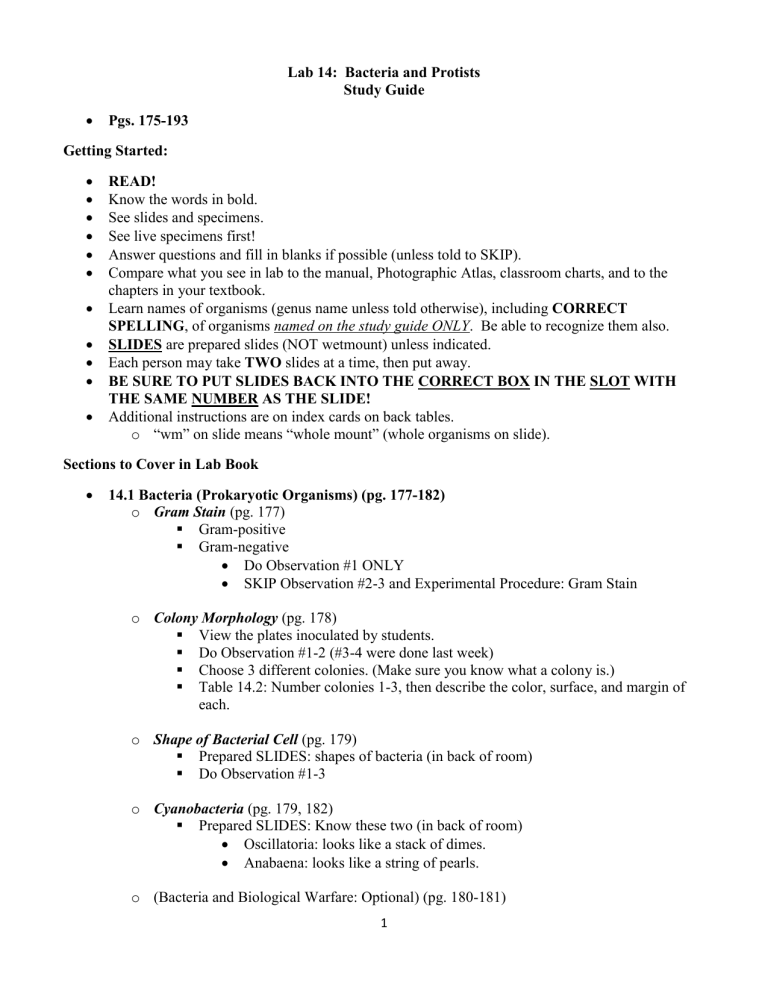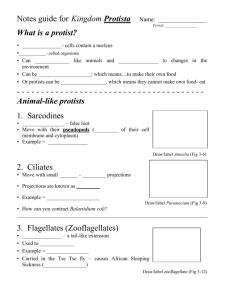Lab 14-Bacteria and Protists Study Guide - Biology102-104

Lab 14: Bacteria and Protists
Study Guide
Pgs. 175-193
Getting Started:
READ!
Know the words in bold.
See slides and specimens.
See live specimens first!
Answer questions and fill in blanks if possible (unless told to SKIP).
Compare what you see in lab to the manual, Photographic Atlas, classroom charts, and to the chapters in your textbook.
Learn names of organisms (genus name unless told otherwise), including CORRECT
SPELLING , of organisms named on the study guide ONLY . Be able to recognize them also.
SLIDES are prepared slides (NOT wetmount) unless indicated.
Each person may take TWO slides at a time, then put away.
BE SURE TO PUT SLIDES BACK INTO THE CORRECT BOX IN THE SLOT WITH
THE SAME NUMBER AS THE SLIDE!
Additional instructions are on index cards on back tables.
o “wm” on slide means “whole mount” (whole organisms on slide).
Sections to Cover in Lab Book
14.1 Bacteria (Prokaryotic Organisms) (pg. 177-182) o Gram Stain (pg. 177)
Gram-positive
Gram-negative
Do Observation #1 ONLY
SKIP Observation #2-3 and Experimental Procedure: Gram Stain o Colony Morphology (pg. 178)
View the plates inoculated by students.
Do Observation #1-2 (#3-4 were done last week)
Choose 3 different colonies. (Make sure you know what a colony is.)
Table 14.2: Number colonies 1-3, then describe the color, surface, and margin of each. o Shape of Bacterial Cell (pg. 179)
Prepared SLIDES: shapes of bacteria (in back of room)
Do Observation #1-3 o Cyanobacteria (pg. 179, 182)
Prepared SLIDES: Know these two (in back of room)
Oscillatoria: looks like a stack of dimes.
Anabaena: looks like a string of pearls. o (Bacteria and Biological Warfare: Optional) (pg. 180-181)
1
14.2 Protists (Eukaryotic Organisms)
See classification and characteristics (pg. 183). This reflects both a new classification system (in the table) and the traditional way of grouping by mode of nutrition. Until a final classification system is universally accepted, we will NOT memorize the names of supergroups. Instead, groups of protists will be studied according to types of nutrition. o Photosynthetic Protists (pg. 183-188) – “plant-like” is the traditional description for autotrophic protists. o Observation: Green Algae
(Living specimens: Volvox and Euglena )
Prepared SLIDES :
Spirogyra , vegetative (“vegetative” means “not reproducing”) o What is its identifying structure?
Spirogyra , sclariform conjugation: this is the type of conjugation shown in Fig. 14.10b. For exams, we will call it simply
“conjugation.”
Volvox , wm: a colonial protest: compare to Fig. 14.11.
o See living culture: gently hold tube up to light to see colonies.
o Make a WETMOUNT SLIDE ! (Use a coverslip.) o (Also see diagram of Chamydomonas , Fig. 14.17, which is similar to an individual cell of Volvox .
SKIP Table 14.3.
Add: Euglena : living culture o Make a WETMOUNT SLIDE !
o Note movements (means of locomotion). o Compare to pg. 25 in manual.
o Observation: Brown Algae
Will only need to recognize Fucus (rockweed).
See preserved specimen.
Know where it grows.
Identify air bladders/air vesicles.
You do not need to know reproduction.
Table 14.4. Use Fig. 14.12 to fill in information about Fucus and
Laminaria .
o Observation: Red algae
See preserved specimens. Know information on index card.
SKIP Table 14.5
o Observation: Diatoms
DEMO SLIDE : marine diatoms (this is a common name: no capitalization, no italics)
See index cards on table. Compare to Fig. 14.14.
2
o Observation: Dinoflagellates
DEMO SLIDE : dinoflagellates (common name): adjust fine focus back and forth to see grooves
Compare to Fig. 14.15.
o Heterotrophic Protists
: “animal-like” is the traditional description for protists that ingest food (protozoans).
o SKIP : Apicomplexans – will probably cover in lecture.
o Know the 3 below: identify type of locomotion and means of obtaining food.
Amoeba : identify pseudopods
Paramecium : adjust light and fine focus to look for cilia. (Can you see the macronucleus and micronucleus?)
Trypanosoma : causes African Sleeping Sickness o Observation: Pond water: SKIP o Slime Molds
: “fungus-like” is the traditional description for these organisms.
Heterotrophic by phagocytosis (similar to amoebas).
o 2 types:
Cellular slime molds: NO SPECIMEN: See text diagram pg. 365.
Acellular slime molds = plasmodial slime molds, named for the plasmodium, a mass of naked cytoplasm.
Physarum – LIVE SPECIMEN, see text pg. 365.
KNOW ANSWERS TO LABORATORY REVIEW!
3

